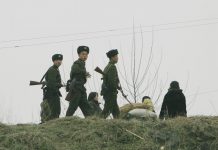
As rice prices continue to increase throughout North Korea’s markets, regional disparities in prices have grown deeper due, at least in part, to severe restrictions on people’s movement in March.
According to Daily NK’s regular survey of prices at North Korean markets, a kilogram of rice was being traded for KPW 5,300 at a marketplace in Pyongyang on Mar. 31. That was KPW 100 higher than the previous survey on Mar. 17. On the same day, a kilogram of rice sold for KPW 5,400 at a market in Sinuiju, North Pyongan Province – once again, KPW 100 more than it had been two weeks before.
In short, rice prices in both Pyongyang and Sinuiju are trending upward in the KPW 5,000–5,500 range.
But at a market in Hyesan, Yanggang Province, rice has already crossed the KPW 6,000 range, with a kilogram trading for KPW 6,200 on Mar. 31. That was KPW 900 more than Pyongyang and KPW 800 more than Sinuiju.
Rice prices in Hyesan were up 8.8% from the previous survey (KPW 5,700 on Mar. 17), rising at a faster rate than prices in Pyongyang and Sinuiju.
This was not the first time that big regional variations have been observed in rice prices. After the first suspected cases of COVID-19 were reported in 2020, North Korea banned most travel between regions, shuttering markets and causing rice prices to fluctuate wildly between different areas of the country.
In mid-June 2021, rice was selling for KPW 3,800 in Pyongyang and KPW 7,000 in Hyesan, representing a difference of KPW 3,200 per kilogram. That was when North Korea was imposing rigid lockdowns on the country, confining citizens to their homes and banning distribution and movement after dead birds were discovered.
However, this was the first time market prices for rice have varied so much without regional lockdowns being in place. The main reason for this could be poor distribution of goods between regions.
“North Korean grain prices exhibit a pattern in which they are higher in the first quarter than in the fourth quarter, but large regional disparities would be irregular outside of the unique circumstances of regional lockdowns. There may be a new factor here that is disrupting grain distribution between regions,” said Choi Ji-young, an analyst with the Korean Institute for National Unification, in a telephone interview with Daily NK.
In fact, North Korea used the beginning of the US and South Korea’s “Freedom Shield” joint military exercises on Mar. 4 as an excuse to restrict people’s movement. That restriction resulted in commercial losses for both truckers and wholesalers who move items from one region to markets in another region for sale. The government continued to restrict movement through Mar. 31.
However, Daily NK’s recent survey found that market prices of corn exhibited less regional variability than rice.
A kilogram of corn was trading for KPW 2,800 at a marketplace in Pyongyang and KPW 3,100 at a marketplace in Hyesan on Mar. 31, indicating there was just a KPW 300 difference between prices in the two regions. Corn prices were edging upward in both cities, with prices KPW 100 higher than they had been two weeks before.
Translated by David Carruth. Edited by Robert Lauler.
Daily NK works with a network of sources living in North Korea, China, and elsewhere. Their identities remain anonymous for security reasons. For more information about Daily NK’s network of reporting partners and information-gathering activities, please visit our FAQ page here.
Please send any comments or questions about this article to dailynkenglish@uni-media.net.

















